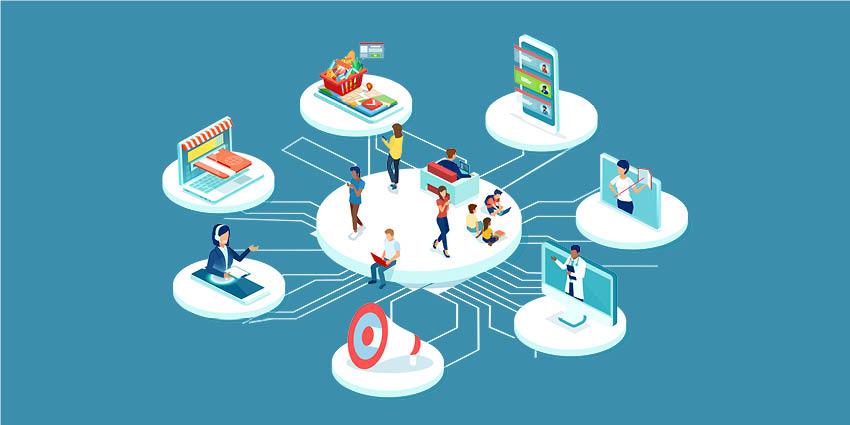For today’s companies, digitizing customer experience is no longer just a way to stay ahead of the competition. In a world where digital transformation is accelerating at an incredible rate, consumers expect brands to take a digital-first approach to CX.
In the last few years, the average customer journey has evolved to include an influx of new channels, from mobile apps to social media platforms. One study in 2023 even found the most successful organizations today invest heavily in technical solutions for CX.
But digitizing customer experience doesn’t just mean ensuring customers can use the channels they prefer to interact with your brand. A comprehensive strategy requires companies to prioritize and optimize each part of the customer journey through digital transformation.
35% of business executives say digital transformation helps them improve operational efficiency and meet customer expectations.
So, where do business leaders begin?
Digitizing Customer Experience: What is CX Digitization?
The first step to “digitizing customer experience” is understanding this term. Creating and optimizing a digital customer experience involves migrating existing processes, tools, and strategies into a digital-first environment.
When companies “digitize” customer experience, they integrate state-of-the-art technologies into all elements of the customer journey map. This could mean bringing new channels like social media and web chat to marketing, sales, and customer service.
It could also involve innovating and implementing new CX strategies centered around digital tools. For instance, companies may leverage analytics, AI, and automation tools to enhance the customer experience throughout digital environments.
Digitizing customer experience also requires companies to find ways of minimizing repetitive tasks, improving efficiency, and boosting productivity with technology.
Digital Customer Experience vs. Customer Experience
Today, digitizing customer experience isn’t just a tactic reserved for larger companies with sizable budgets. Every customer in every industry now expects a fully omnichannel and aligned CX experience across multiple channels. However, only 10% of companies offer their customers a truly “omnichannel” experience.
Notably, the terms “digital customer experience” and “customer experience” are becoming increasingly aligned, though they have different meanings. “Customer Experience” or “CX” refers to the entire customer experience, both physical and virtual.
Digital customer experience, or “DCX,” refers to the experience given to customers across digital channels, such as social media platforms, mobile apps, and websites. To deliver an excellent customer experience in today’s world, companies need to embed “DCX” into their broader “CX” landscape on a comprehensive level.
Digital natives in the customer landscape are taking over the buyer space, making it almost impossible for any organization to thrive without a basic digital strategy.
The Benefits of Digitizing Customer Experience
As mentioned above, digitizing customer experience is quickly becoming essential for companies of all sizes in every industry. On a basic level, a digitization strategy is crucial to delivering an exceptional experience to your target audience.
Innovative tools, such as analytical platforms, machine learning algorithms, and even generative AI, are all helping to transform customer experiences in various ways. These tools help to make interactions more personalized and efficient. They can empower employees to accomplish more quickly and increase engagement with proactive follow-ups and messages.
Digital tools also make it easier for companies to track and learn from customer interactions. By allowing businesses to collect valuable data, these solutions can assist businesses in strengthening brand loyalty and increasing sales.
Used correctly, a plan for digitizing customer experience:
- Increases customer satisfaction: 9 out of 10 customers agree the experience offered by a company is as important as its products and services. A digital strategy ensures you can connect with customers on the proper channels and personalize their experiences.
- Improves customer engagement: Digital technologies help companies to engage with customers on a consistent level. They can automatically send marketing and sales messages, respond promptly to inquiries, and even enable self-service.
- Improves insights: With digital tools, companies can gain insights into customer preferences, buyer habits, and more. This makes it easier to create more advanced customer experiences, increase sales, and generate loyalty.
Digitizing Customer Experience: Steps for Getting Started
The path to digitizing customer experiences can seem complex. Trends in customer experience, communication, and buying habits are constantly changing. This means companies must consistently optimize and enhance their digital strategy.
However, there are a few steps you can follow to pave the way for success.
1. Create User Personas
Truly innovative customer experiences in the digital world must be specific and personalized to the customer’s needs. To know where to begin when digitizing customer experience, you must first understand your customers and target audience.
Creating data-led customer personas, or user personas, helps you to identify the critical touchpoints in the customer journey you may need to update. These personas should provide an overview of your customer’s pain points, demographics, buying patterns, and motivations.
Personas will also help you to identify and build a complete customer journey map. This will offer a visual insight into how personas move through digital experiences. It’s also worth examining the experiences and services provided by your competitors to see how they compare to your own CX strategy.
2. Build an Omnichannel Customer Service Strategy
As mentioned above, today’s customer journeys involve various channels and touchpoints. When digitizing customer experience for your business, it’s worth ensuring you can connect with customers consistently across all media they use.
An omnichannel environment doesn’t just link multiple channels like social media and web chat. It also removes the silos between those channels, ensuring data and information flow freely from one environment to the next.
Using omnichannel CCaaS platforms that integrate with other tools like CRM and ERP systems will make it easier to visualize and enhance every customer journey stage. It also ensures your employees can connect with customers in a personalized, engaging format.
3. Leverage Evolving Service Channels
Truly digitizing customer experience means thinking beyond the basic service channels you may have used in the past, such as email and phone calls. While these platforms are still crucial to the customer experience, you’ll also need to implement new solutions.
For instance, live chat is one of the most influential and popular tools for customer service in the modern market. Both live and AI-driven chatbots empower companies to connect with consumers in new, more efficient ways. There are even generative AI solutions available to offer creative and personalized self-service experiences.
Chat solutions can help customers interact with and solve problems quickly, reach out to customers proactively, and boost engagement. Alongside chat, new channels like SMS interactions and social media are becoming increasingly popular.
Even video is rapidly becoming an essential component of the CX environment, bringing more context and human input into each interaction.
4. Use Data When Digitizing Customer Experience
Truly digitizing customer experience doesn’t just mean adding new digital channels to your contact center environment. It also means leveraging next-level technology to enhance how you serve your customers. Tools that help companies capture customer experience analytics and insights offer a valuable way to optimize the customer journey.
With intelligent solutions, companies can rapidly capture information about customer preferences and pain points, using it to personalize every interaction. The correct data and analytics can make scheduling and aligning employees in a distributed contact center easier.
Taking advantage of advanced analytical tools, which capture information throughout the customer journey, ensures companies can invest their budget in the strategies and tools most likely to enhance customer loyalty and boost retention.
Remember, 66% of customer expect companies to understand their unique expectations and needs. You need data if you’re going to truly understand your audience.
5. Train agents in Digitizing Customer Experience
When updating your customer experience strategy, a few things are more important than providing your agents with the correct training. As new channels emerge in your contact center, your customer service and sales teams will need new skills.
Teaching team members how to correctly use intelligent assistants, analytical tools, and new channels is crucial for various reasons. Not only does it ensure rapid adoption of new digital media for customer service, but it also helps to preserve compliance.
There are even tools available that can help companies to deliver guidance and support to team members consistently. For instance, with specific CCaaS platforms, companies can provide real-time AI-driven advice or coaching.
6. Implement AI with Caution
Artificial Intelligence is quickly becoming an essential part of digitizing customer experience. AI solutions empower companies to bring new self-service capabilities and experiences to consumers with generative chatbots and assistants.
Plus, AI solutions ensure companies can capture and leverage data more effectively throughout the contact center with intuitive analytics. AI systems can even automate various parts of the consumer and employee journey, improving efficiency and productivity.
However, it’s essential to implement these solutions with caution. Overuse of AI may result in unexpected exceptions and errors that only add friction instead of removing it. Iterative tasks, high-volume processes, data transfers, and language analysis are best done through AI.
7. Balance Experimentation with Standardization
A standardized plan for digitizing customer experience should make training agents, designing processes, and implementing the right technologies easier. However, an overly conservative focus on standardization could increase resistance to change.
Companies must combine ethical and compliant practices with experimentation to stay ahead of the competition. Leveraging and tracking the correct information is an excellent way to find the right balance. Ensure you know the compliance standards for various forms of customer communication in your industry.
At the same time, track user behavior, trends, and opportunities in the marketplace as new technologies emerge. The right tools should help you monitor essential information to ensure compliance and innovation can work together.
8. Collect Qualitative Feedback
While quantitative data about call handling times, response rates, and other factors can help when digitizing customer experience, it’s also crucial to collect qualitative data. The voice of the customer should form an essential component of your strategy for long-term growth.
Gathering in-depth feedback will help you determine which parts of your digital customer service strategy drive loyalty and retention. You’ll be able to collect suggestions from your audience on how you can improve their journey and make more meaningful changes in the future.
Moreover, your feedback management approach will make analyzing essential KPIs such as CSAT and NPS scores easier. Some innovative tools can add to these insights with contextual information from real-time sentiment analysis.
9. Consider Every Part of the Customer Journey
Finally, it’s worth remembering the customer journey involves more than just sales and customer service. To truly invest in digitizing customer experience, companies need to consider every aspect of their customer relationship.
This could mean implementing new automated marketing strategies, reaching out to customers, and following up with them across multiple channels. It could also mean crafting new strategies for onboarding customers and investing in customer success.
A holistic approach to digitizing customer experience ensures companies can build powerful, long-term consumer relationships, minimizing churn.
Ensuring Success with Digitizing Customer Experience
Virtually every company should be thinking about their strategy for digitizing customer experience in the modern world. However, there are some roadblocks and challenges to overcome.
For instance, many companies make the mistake of embracing new tools and technologies simply because they appear innovative or competitive. However, every solution in your CX strategy should serve a specific purpose or goal.
A clearly articulated blueprint will define the objectives and expected outcomes from the initiative so that the company does not only innovate for the sake of innovation.
It’s also worth remembering that true digitization may require investing in replacing old tools and technologies. Legacy infrastructure rarely gives companies the agility to digitize and evolve consistently. However, a cloud-based environment ensures organizations can adapt to the trends in their marketplace and the needs of their audience.







